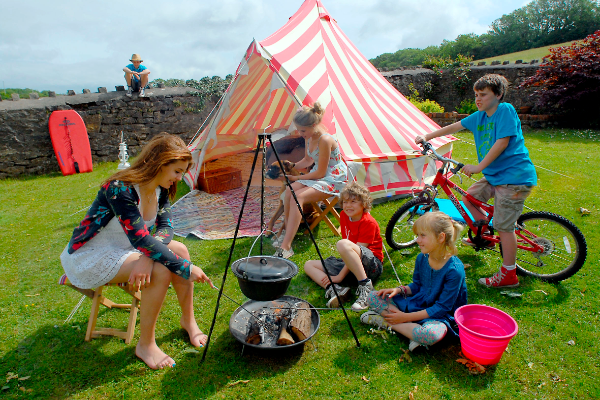Camping is a fantastic way to connect with nature, unwind, and spend quality time with friends and family. Whether you’re a seasoned camper or a first-timer, planning and knowing what activities to engage in can make your trip memorable. Here’s a comprehensive guide on what to do on a camping trip.
See Also: Best Canvas Family Tent: Durable and Spacious Shelters
Planning Your Camping Trip
Choose the Right Campsite
Research campsites: Look for locations that match your preferences and skill level.
Consider amenities: Check for available facilities such as bathrooms, water, and picnic areas.
Book in advance: Popular sites fill up quickly, especially during peak seasons.
Pack Essential Gear
Tent and sleeping gear: Choose a tent appropriate for the weather and your group size. Bring sleeping bags and pads.
Cooking supplies: Pack a portable stove, fuel, cooking utensils, and food.
Clothing: Bring layers, rain gear, and appropriate footwear.
Safety and navigation: Carry a map, compass, first-aid kit, and a flashlight.
Plan Your Meals
Create a menu: Plan easy-to-cook meals that cater to everyone’s dietary needs.
Pack non-perishables: Include items like canned goods, dried fruits, and nuts.
Bring a cooler: Keep perishables fresh with ice packs.
Setting Up Camp
Arrive Early
Get to the campsite early to choose the best spot and set up before dark.
Pitch Your Tent
Find flat ground: Look for an area free of rocks and roots.
Secure the tent: Use stakes and guy lines to ensure stability, especially in windy conditions.
Organize Your Campsite
Set up a kitchen area: Designate a space for cooking and food storage away from your sleeping area.
Create a relaxation zone: Set up chairs and a table for eating and socializing.
Ensure safety: Keep a clean camp to avoid attracting wildlife.
Activities During the Day
Hiking
Choose trails: Select hikes based on your fitness level and the time you have.
Pack essentials: Bring water, snacks, a map, and a first-aid kit.
Wear appropriate gear: Use sturdy hiking boots and dress in layers.
Fishing
Check regulations: Make sure you have the necessary permits and follow local fishing rules.
Pack gear: Bring rods, bait, and tackle.
Find a good spot: Look for areas where fish are known to be plentiful.
Wildlife Watching
Bring binoculars: Enhance your viewing experience.
Stay quiet: Approach wildlife slowly and silently.
Respect nature: Keep a safe distance and do not feed the animals.
Swimming
Find a safe spot: Ensure the water is clean and free of strong currents.
Supervise children: Always keep an eye on young swimmers.
Wear water shoes: Protect your feet from sharp objects.
Evening Activities
Campfire Cooking
Gather firewood: Collect dry wood or purchase it if required.
Build a fire: Follow campsite rules for fire safety.
Cook simple meals: Grill hot dogs, roast marshmallows, or prepare foil packet dinners.
Stargazing
Check the weather: Choose a clear night for the best view.
Use a star chart: Identify constellations and planets.
Bring a telescope: Enhance your stargazing experience.
Storytelling
Share campfire stories: Take turns telling fun or spooky tales.
Use props: Bring books or use shadow puppets to enhance the storytelling.
Night Hikes
Bring a flashlight: Ensure visibility on dark trails.
Stick to familiar paths: Avoid getting lost by staying on known trails.
Observe nocturnal wildlife: Look for animals active at night.
Staying Active
Morning Exercise
Stretching: Start your day with a light stretch.
Yoga: Bring a mat and practice yoga in nature.
Short runs: Go for a jog around the campsite.
Games and Sports
Frisbee: Play a game of catch or disc golf.
Volleyball: Set up a net and enjoy a match.
Badminton: Bring racquets and a shuttlecock.
Water Activities
Canoeing: Explore nearby lakes or rivers.
Kayaking: Paddle through calm waters.
Paddleboarding: Try stand-up paddleboarding for a core workout.
Exploring the Area
Visit Local Attractions
Parks: Check out nearby national or state parks.
Historical sites: Learn about the area’s history.
Scenic spots: Find viewpoints for beautiful photos.
Guided Tours
Join a guided hike: Learn from knowledgeable guides.
Participate in a nature walk: Discover local flora and fauna.
Take a boat tour: Explore waterways and spot wildlife.
Photography
Capture landscapes: Take photos of mountains, forests, and lakes.
Photograph wildlife: Use a zoom lens to get close-up shots.
Shoot at different times: Experiment with lighting during sunrise and sunset.
Relaxing and Unwinding
Reading
Bring a good book: Enjoy some quiet reading time.
Use a hammock: Set up a hammock for a comfortable reading spot.
Choose nature-themed books: Get inspired by outdoor adventures.
Meditation
Find a peaceful spot: Choose a quiet area for meditation.
Use a mat or cushion: Sit comfortably on the ground.
Practice deep breathing: Focus on your breath and relax.
Journaling
Document your trip: Write about your experiences and feelings.
Sketch nature scenes: Draw the landscapes and wildlife you encounter.
Reflect on your goals: Use the time to think about personal growth.
Safety Tips
Stay Hydrated
Drink plenty of water: Carry a reusable water bottle.
Purify water: Use a filter or purification tablets if necessary.
Protect from Sun
Wear sunscreen: Apply regularly to exposed skin.
Use sunglasses: Protect your eyes from UV rays.
Wear a hat: Shield your face and neck from the sun.
Avoid Wildlife Encounters
Store food properly: Use bear-proof containers if required.
Keep a safe distance: Do not approach wild animals.
Know what to do: Understand how to react if you encounter wildlife.
First Aid
Pack a first-aid kit: Include bandages, antiseptics, and pain relievers.
Know basic first aid: Learn how to treat common injuries.
Stay calm: Keep your composure in case of an emergency.
Conclusion
Camping offers endless opportunities for adventure, relaxation, and bonding with nature. By planning ahead and engaging in various activities, you can make your camping trip an unforgettable experience. Remember to respect the environment and practice safety at all times. Happy camping!

